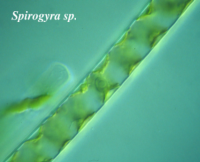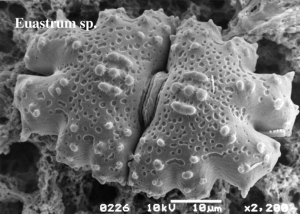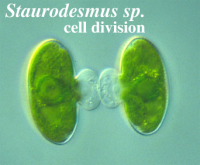Molecular phylogeny of the conjugating green algae (Zygnemophyceae, Streptophyta)
The conjugating green algae have fascinated professional and amateur microscopists for over 200 years because of their morphological diversity and complex cell symmetry, which make them organisms of great natural beauty. This attraction resulted in the description of a large number of "species" (approximately 4000, the exact number has never been known with any certainty; Hoshaw and McCourt 1988; Gerrath 1993). The distinctness of the Zygnemophyceae, which are characterized
by a special type of sexual reproduction (conjugation) and the complete absence
of flagellate reproductive stages, has never been in doubt (Brook
1981). However, the relationships of the different taxonomic entities (orders,
families, genera, species) to each other as well as the genus and species concepts
in the group have remained controversial and elusive. Ultrastructural and molecular
phylogenetic data suggested clear affinities of the Zygnemophyceae a paraphyletic
assemblage of green algae previously known as the Charophyceae (sensu Mattox and Stewart 1984) and the embryophyte land plants.
In a cladistic framework (Bremer 1985; Bremer et al. 1987;
Kenrick and Crane 1997) the conjugating green algae are designated as class
Zygnemophyceae (= Zygnematophyceae; Hoek et al. 1995) within the division Streptophyta, which
together with the Chlorophyta form the green plants.
The distinctness of the Zygnemophyceae, which are characterized
by a special type of sexual reproduction (conjugation) and the complete absence
of flagellate reproductive stages, has never been in doubt (Brook
1981). However, the relationships of the different taxonomic entities (orders,
families, genera, species) to each other as well as the genus and species concepts
in the group have remained controversial and elusive. Ultrastructural and molecular
phylogenetic data suggested clear affinities of the Zygnemophyceae a paraphyletic
assemblage of green algae previously known as the Charophyceae (sensu Mattox and Stewart 1984) and the embryophyte land plants.
In a cladistic framework (Bremer 1985; Bremer et al. 1987;
Kenrick and Crane 1997) the conjugating green algae are designated as class
Zygnemophyceae (= Zygnematophyceae; Hoek et al. 1995) within the division Streptophyta, which
together with the Chlorophyta form the green plants. 
Classification schemes of the Zygnemophyceae have been generally based on morphology, emphasizing cell wall ultrastructure, cellular organization (unicells, filaments) and chloroplast structure. Two orders based on cell wall structure are traditionally distinguished, the Zygnematales and the Desmidiales. The Zygnematales are characterized by smooth cell walls consisting of a single piece and lacking pores and other ornamentations. Zygnematalean taxa forming filaments are distinguished as the family Zygnemataceae from the unicellular Zygnematales classified as the Mesotaeniaceae and formerly known as "saccoderm desmids". The Desmidiales (or "placoderm desmids") have cell walls consisting of two or more pieces further characterized by ornamentations and pores (Mix 1972). Based on cellular organization and cell wall features the Desmidiales are subdivided into three or four families, the Peniaceae, Gonatozygaceae (merged with the Peniaceae by Kouwets and Coesel 1984), Closteriacea e and Desmidiaceae. Genera and species of the Zygnemophyceae are mostly based on differences in cell organization (filaments/unicells), cell symmetry, size and shape, cell wall projections and ornamentations and chloroplast structure. In most taxa neither the stability of the taxonomic characters nor their evolutionary status (plesiomorphic or apomorphic) have been studied in any detail.

In this project we use a number of genes and molecular tools and address a range of phylogenetic and evolutionary questions in the Zygnemophyceae, namely the relationships between orders and families, the generic structure within some families (Zygnemataceae, Mesotaeniaceae, Peniaceae and Desmidiaceae) and the genus concept in the families Mesotaeniaceae and Desmidiaceae.
Publications
Gontcharov AA (1996). The algal flora of the Primorsky Region, Russian Far East. Hydrobiologia 336: 93-97
Gontcharov AA, Watanabe M (1999). Brachytheca sulcata gen. et sp. nov. (Desmidiaceae, Chlorophyta), a new alga from the highlands of Papua New Guinea. Phycologia 38: 345-348
Gontcharov AA, Marin B, Melkonian M (2003). Molecular phylogeny of conjugating green algae (Zygnemophyceae, Streptophyta) inferred from SSU rDNA sequence comparisons. J. Mol. Evol. 56: 89-104
Gontcharov AA, Melkonian M (2004): Unusual position of the genus Spirotaenia
(Zygnematophyceae) among streptophytes revealed by SSU rDNA and rbcL sequence
comparisons.
Phycologia 43: 105-113
Gontcharov AA, Marin B, Melkonian M (2004). Are combined analyses better than single gene phylogenies? A case study using SSU rDNA and rbcL sequence comparisons in the Zygnematophyceae (Streptophyta). Mol. Biol. Evol. 21: 612-624
